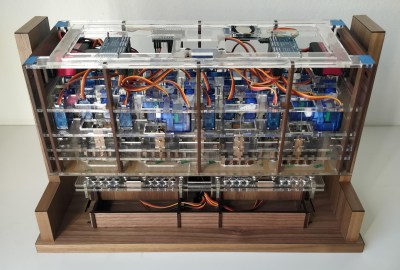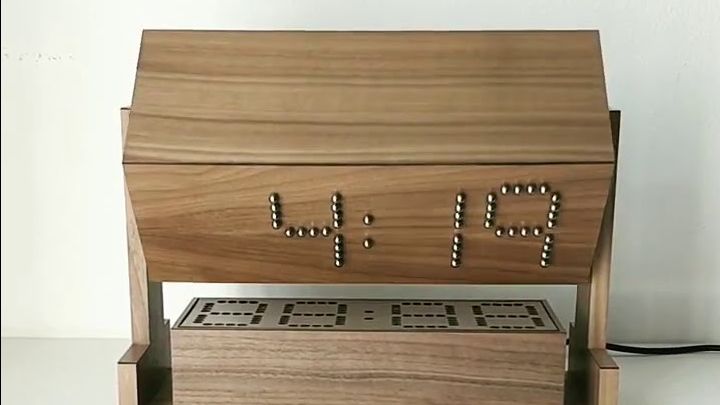In the neverending quest for unique ways to display the time, hackers will try just about anything. We’ve seen it all, or at least we thought we had, and then up popped this purely mechanical digital clock that uses nothing but steel balls to display the time. And we absolutely love it!

One glimpse at the still images or the brief video below shows you exactly how [Eric Nguyen] managed to pull this off. Each segment of the display is made up of four 0.25″ (6.35 mm) steel balls, picked up and held in place by magnets behind the plain wood face of the clock. But the electromechanical complexity needed to accomplish that is the impressive part of the build. Each segment requires two servos, for a whopping 28 units plus one for the colon. Add to that the two heavy-duty servos needed to tilt the head and the four needed to lift the tray holding the steel balls, and the level of complexity is way up there. And yet, [Eric] still managed to make the interior, which is packed with a laser-cut acrylic skeleton, neat and presentable, as well he might since watching the insides work is pretty satisfying.
We love the level of craftsmanship and creativity on this build, congratulations to [Eric] on making his first Arduino build so hard to top. We’ve seen other mechanical digital displays before, but this one is really a work of art.
Thanks to [Ruhan van der Berg] for the tip.
















its 4:20. quick, get the bong!
No, please not. Just let us roll one. :-)
+1 for the title Dan ;-) This is a awesome build Eric. Well done.
Once a twelve-year-old boy, always a twelve-year-old boy ;-)
Who cut the cheese?
4:20 eh?
Nice build!
Why not an array of latching solenoids with a magnet attached to the end? Far fewer moving parts.
Why not electro magnets in the first place?
Because they’d have to hold while it’s on. Too much juice.
OK, this is an amazing build, just one aesthetic suggestion, instead of rotating the “face” back to return the balls just deactivate the magnets, let them fall into a return hopper and then pick up more balls, but this is really a piece of horological legerdemain (i.e. clock good.)
He talked about that being the original idea, and even shows a prototype digit that he made that has channels for returning the balls to their proper place. But if Wintergatan has taught us anything, it’s that your balls don’t always do what you want them to do, and they often end up in places they’re not supposed to be. Chances are pretty good one or more segment would end up missing balls, and that could obviously lead to confusion.
Plus, noise.
“would end up missing balls, and that could obviously lead to confusion.”
and sadness! B^(
Amazing feat to include all those servos.
Nice woodworking too.
I suppose replacing all the moving hardware and permanent magnets with a bank of electromagnets will simplify it a bit, at the cost of a lot of power consumption. And having to pick up dozens of balls off the floor every time the power is interrupted…
What about using electropermanent magnets though? Seen in these hallowed pages way back in https://hackaday.com/2013/07/12/electro-permanent-magnets-for-quadcopters/ Now being proposed as a small-satellite docking grapple by https://altius-space.com/ , among others. Much more info on https://en.wikipedia.org/wiki/Electropermanent_magnet too.
having played with electropermanent magnet i can tell you that they are a big PITA.. Much easier to just have normal electromagnets. Controlling one or two electroPermanent magnet is fine . a whole bunch of them messy and difficult to get right
Really cool build . !
It would have been easier to use permanent magnets with coils around them instead of the complicated servo mechanics. but of course than it wouldn’t be not so much servo fun.
But, but, but… wait !?!? The seconds aren’t displayed???
Uh nice, but this isn’t ‘purely mechanical’! I was expecting springs and clockwork gears, and instead we got an arduino and some servos.
Slight correction: each segment requires just one servo (as you’d expect). The doubling comes from there being 2 digits each for the hours and minutes.
Okay, here’s the next challenge: Make a clock that uses steel balls like this, but uses something like a shift register with a track that snakes throughout all the digits. Balls get picked up from a source and shift their way along the track, with empty spaces as needed to form the digits once everything has been shifted into place. The end of the track feeds back into the source hopper.
At least you will know if there is a power outage when the balls hit the floor in a rush.
Very nice and creative ! I keep wondering about a new way to display time, something unique, and then a build like this comes along and I have to think “Crap, another good idea I didn’t have.”
“plus one for the colon” Never forget the colon.
Incredible!!
Incrediball !
: )
I really hope you’re not trying to fall asleep with one of these operating in your room…